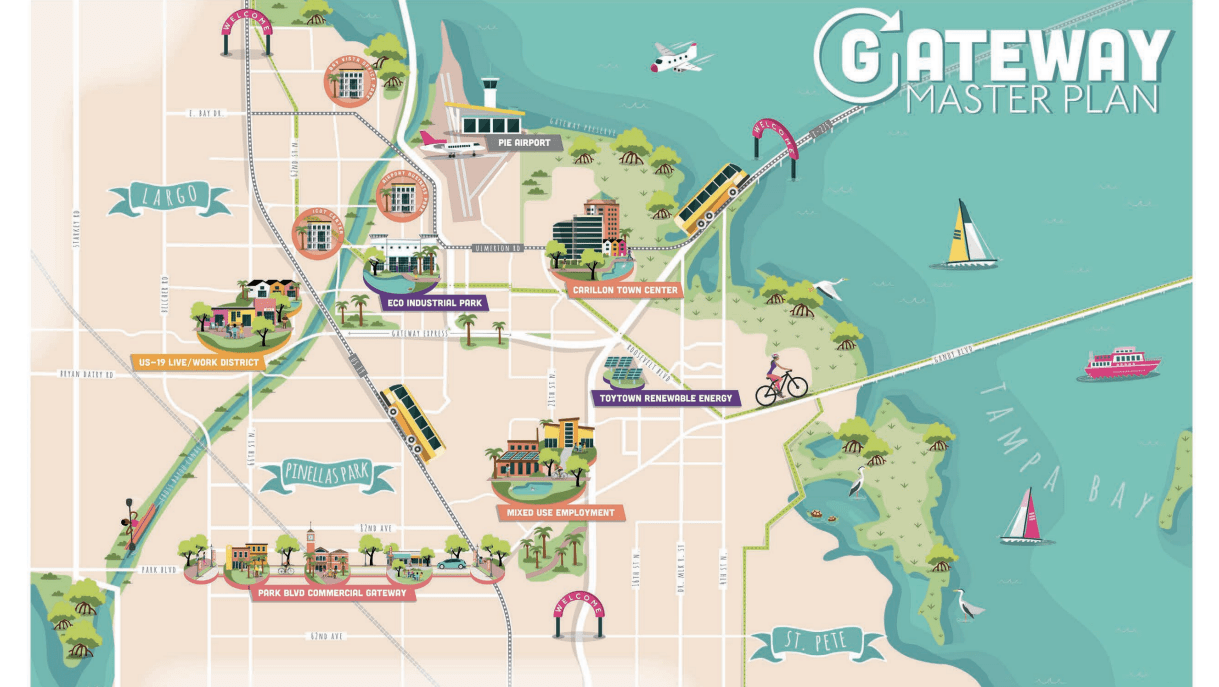Thrive
Reimagining the Gateway: Here’s what it could look like in 2045

The Gateway area serves as a regional crossroads. Comprised of North St. Petersburg, Pinellas Park and Largo, Gateway lies at the center of two international airports, six major highways and four bridges. It is also Pinellas County’s economic engine. In fact, thanks to the Gateway area, Pinellas ranks in the top three throughout the state for manufacturing jobs.
Gateway is home to Jabil, Raymond James Financial and HSN, making it one of the most jobs-rich regions in the state. It employs 115,000 people, or 10 percent of Pinellas County’s total job market, and is accessible to over 712,000 potential employees within 30 minutes. But with all of the benefits of being a transportation hub come alongside the numerous challenges of a region largely known for its commuting workforce.
Congestion and stop-and-go rush hour traffic are expected in Gateway. It is known as a commuter’s nightmare of tangled interstates, highways and on/off ramps. But changes are afoot. Forward Pinellas’ Whit Blanton presented the Gateway Master Plan to the City Council’s Housing Land Use and Transportation Committee late last month. The Master Plan envisions transformative changes for the Gateway area over the next 25 years.
“I know that some parts of his might seem kind of dry but actually this is really, really exciting,” City Council member Darden Rice said of the project. “If you could think of some of the most haphazardly developed, ugly places in the county, you might find it in this area up until now.”
The plan’s framework includes multi-modal transportation, land use and innovation, triple bottom line resilience (environmental, human well-being and economic) and sustainable infrastructure.

Multi-modal Transportation
One of the most important facets of the plan is transportation. The Gateway area is just that, a gateway between Pinellas and Hillsborough County. Six major highways and four bridges bring people in and out of the Gateway area every day. That geographic situation makes it the perfect site for a future Intermodal Transportation Center. While the specific site has not yet been nailed down, the intersection of Roosevelt and 28th Street was proposed as a feasible choice.
That center would help unify the three-county area, and serve as a hub for the proposed future rapid transit service (the first piece of which would be St. Petersburg Central Avenue BRT line) linking downtown St. Pete/St. Pete Beach to Tampa International Airport. Other major transportation projects are already in the works, including the $580 million Gateway Expressway plan, which will connect I-275 to US-19 and Bayside Bridge with elevated toll roads. The project is scheduled to be open in 2022 and is intended to relieve congestion along Roosevelt Boulevard and Ulmerton Road.
Other focuses would include walkability and bike-ability in the Gateway area. Specific solutions could include pedestrian overpasses, added and improving sidewalks, and intersection improvements to ensure the safety of pedestrian crosswalks.

Land Use and Innovation
The plan suggests a number of ways in which the Gateway area could be better utilized and better planned to encourage innovation and re-position underutilized land for further development. The plan calls for integrating zoning and land uses, and increasing density to remove regulatory burdens from development. Removing these obstacles could encourage a number of development concepts outlined in the plan, including an eco-industrial park, mixed-use employment centers, live/work districts, and an airport business park surrounding St. Petersburg-Clearwater Airport. These mixed districts could incentivize building sorely needed office space by encouraging pooling resources like parking infrastructure, to fully utilize and share existing infrastructure, reduce costs and preserve public green space.
Triple Bottom Line Resilience
No regional plan is complete without considerations of climate mitigation. The Gateway Master Plan considers both environmental vulnerabilities like storm surge and sea level rise, and opportunities like productive landscapes to mitigate such harm. Triple bottom line resilience includes economic, environmental and social areas of need and how those interact with the risks associated with climate change. The plan considers concepts like flood mitigation, thermal comfort, renewable energy, green space, resiliency hubs and resilient building codes.

Sustainable Infrastructure
Sustainable infrastructure goes hand in hand with resilience. The Gateway Master Plan focuses on stormwater mitigation strategies, including maintenance of the Cross Bayou Canal, expanding existing retention ponds, and the construction of additional channels through Old Tampa Bay. Sustainable infrastructure also seeks to link amenities to create community hubs, connected open space system, parks and trails to serve as safe transportation infrastructure, support community health.
According to Blanton, the Gateway Master Plan is still in the planning process. The preliminary presentation to the Housing, Land Use and Transportation Committee will be distilled down into guiding principles, which will eventually be brought to each of the local government partners. Those guiding principles will be spelled out as a memorandum of understanding for each of the four individual jurisdictions, as well as the Florida Department of Transportation (FDOT) and Pinellas Suncoast Transit Authority (PSTA).
Forward Pinellas, the organization driving the Gateway Master Plan, is already drafting revisions to the Countywide Plan to ease regulatory barriers around intensifying and densifying transit corridors. Blanton argued that it will take “catalytic investments” like the regional BRT system and the Intermodal Transportation Center to stimulate the Gateway area and transform it into a destination.
“I do represent this area and I’m very excited to hear words like destination,” said Council member Brandi Gabbard. “Because there’s so much potential there. There’s a reason they call us the Gateway. Our place in regional efforts is so important.”
Read the full Gateway Master Plan here.

